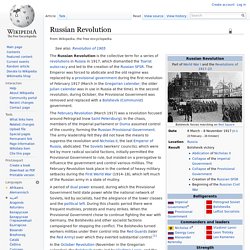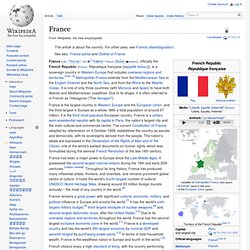

United States. The United States of America (USA), commonly referred to as the United States (US), America or simply the States, is a federal republic[10][11] consisting of 50 states and a federal district. The 48 contiguous states and the federal district of Washington, D.C., are in central North America between Canada and Mexico. Russia. Country spanning Eastern Europe and Northern Asia Coordinates: 60°N 90°E / 60°N 90°E / 60; 90 Russia (Russian: Россия, Rossiya, Russian pronunciation: [rɐˈsʲijə]), or the Russian Federation,[c] is a transcontinental country spanning Eastern Europe and Northern Asia.

It covers over 17,125,191 square kilometres (6,612,073 sq mi), consists of more than one-eighth of the Earth's inhabited land area, extends to eleven time zones, and has borders with sixteen sovereign nations. Moscow is the country's capital and largest city, while Saint Petersburg is the second-largest city. Russian Revolution (1917) The Russian Revolution is the collective term for a series of revolutions in Russia in 1917, which dismantled the Tsarist autocracy and led to the creation of the Russian SFSR.

The Emperor was forced to abdicate and the old regime was replaced by a provisional government during the first revolution of February 1917 (March in the Gregorian calendar; the older Julian calendar was in use in Russia at the time). In the second revolution, during October, the Provisional Government was removed and replaced with a Bolshevik (Communist) government. In the October Revolution (November in the Gregorian calendar), the Bolshevik party, led by Vladimir Lenin, and the workers' Soviets, overthrew the Provisional Government in Petrograd. The Bolsheviks appointed themselves as leaders of various government ministries and seized control of the countryside, establishing the Cheka to quash dissent. Background World War I prompted a Russian outcry directed at Tsar Nicholas II. Economic and social changes. Darkness at Noon. Darkness at Noon (German: Sonnenfinsternis) is a novel by the Hungarian-born British novelist Arthur Koestler, first published in 1940.

His best known work, it is the tale of Rubashov, an Old Bolshevik who is arrested, imprisoned, and tried for treason against the government which he had helped to create. Set in 1938 during the Stalinist Great Purge and Moscow show trials, the novel does not name either Russia or the USSR; the characters have Russian names. Joseph Stalin is alluded to as "Number One", a menacing dictator. The novel expresses the author's disillusionment with the Soviet Union's practice of Communism. In 1998, the Modern Library ranked Darkness at Noon at number eight on its list of the 100 best English-language novels of the 20th century. Background[edit] Koestler wrote Darkness at Noon in German while living in Paris. Setting[edit] Characters[edit] Secondary characters include some fellow prisoners: No. 1, representing Joseph Stalin, dictator of the USSR.
Plot summary[edit] China. China ( i/ˈtʃaɪnə/; Chinese: 中国; pinyin: Zhōngguó), officially the People's Republic of China (PRC), is a sovereign state located in East Asia.

It is the world's most populous country, with a population of over 1.35 billion. The PRC is a single-party state governed by the Communist Party, with its seat of government in the capital city of Beijing.[15] It exercises jurisdiction over 22 provinces, five autonomous regions, four direct-controlled municipalities (Beijing, Tianjin, Shanghai, and Chongqing), and two mostly self-governing special administrative regions (Hong Kong and Macau). The PRC also claims Taiwan – which is controlled by the Republic of China (ROC), a separate political entity – as its 23rd province, a claim which is controversial due to the complex political status of Taiwan.[16] Etymology History Prehistory Early dynastic rule Imperial China.
France. France (UK: /ˈfrɑːns/; US: i/ˈfræns/; French: [fʁɑ̃s] ( )), officially the French Republic (French: République française [ʁepyblik fʁɑ̃sɛz]), is a sovereign country in Western Europe that includes overseas regions and territories.

[note 13] Metropolitan France extends from the Mediterranean Sea to the English Channel and the North Sea, and from the Rhine to the Atlantic Ocean. It is one of only three countries (with Morocco and Spain) to have both Atlantic and Mediterranean coastlines. Due to its shape, it is often referred to in French as l’Hexagone ("The Hexagon"). France is the largest country in Western Europe and the European Union, and the third-largest in Europe as a whole.
France has been a major power in Europe since the Late Middle Ages. Etymology History Prehistory One of the Lascaux paintings of which depicts a horse (Dordogne, approximately 18,000 BC). Gaul Kingdom of Francia (3rd century–843) England. England ( i/ˈɪŋɡlənd/) is a country that is part of the United Kingdom.[1][2][3] It shares land borders with Scotland to the north and Wales to the west.
